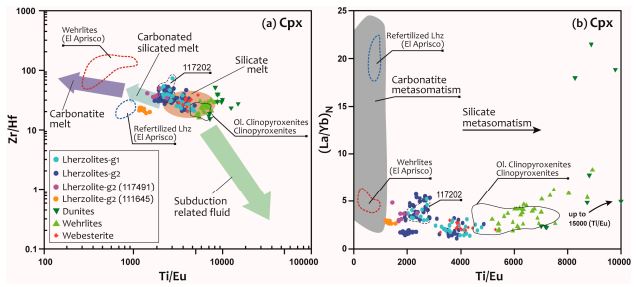
Javier García Serrano (et al.)-
Much of the lithospheric subcontinental mantle (SCLM) sampled in the Calatrava Volcanic Field (CVF) shows refertilization by alkaline metasomatic agents. The Cerro Pelado and El Palo ultramafic xenolith suites record the best evidence of this type of metasomatism in this volcanic field. Several groups of peridotite (lherzolite, wehrlite, and dunite) and pyroxenite (clinopyroxenite and websterite) xenoliths have been distinguished. Despite having scarce phlogopites and amphiboles as modal metasomatic phases, all studied xenoliths present a variable cryptic metasomatism, highlighted by the strong Fe-Ti enrichment and fractionated REE patterns in the most evolved wehrlite and pyroxenite varieties. They show a common trend of an Fe-Ti-Ca increase, whereas the pyroxenites are more depleted in Fe compared to the lherzolites and wehrlites. Trace-element (REE and multi-trace) patterns are roughly similar among them, suggesting different interactions and refertilization degrees by alkaline silicate melts. The same Sr–Nd isotopic EAR composition, combined with trace-element chemistry of metasomatic xenolith phases and phenocrysts from the Calatrava volcanics, highlights the main role of this magmatism in percolation processes beneath Central Iberia. These mantle xenoliths also show variable amounts of interstitial glass that originated by in situ partial melting, favored by the enriched chemical nature of cryptically metasomatized clinopyroxene during their volcanic transport. This alkaline-refertilized mantle type represents the main domain within the SCLM beneath Central Iberia, as was also recorded in other Western European Cenozoic volcanic fields.
